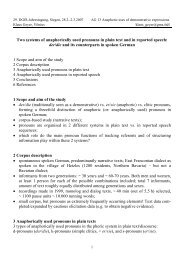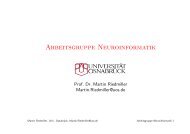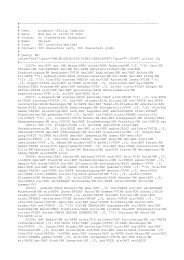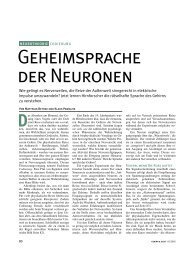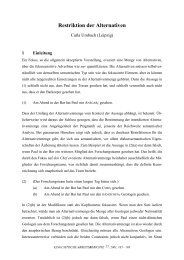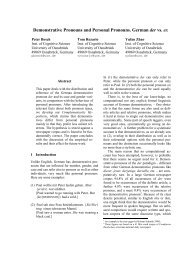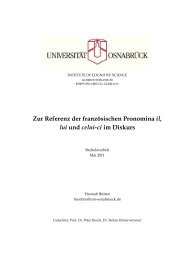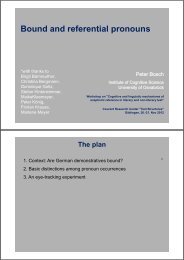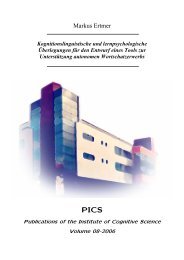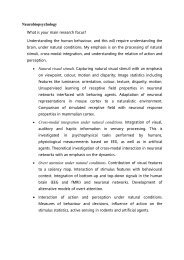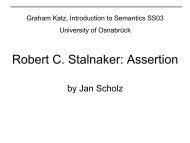Proceedings of the 6th Annual Meeting of the - Heinrich-Heine ...
Proceedings of the 6th Annual Meeting of the - Heinrich-Heine ...
Proceedings of the 6th Annual Meeting of the - Heinrich-Heine ...
You also want an ePaper? Increase the reach of your titles
YUMPU automatically turns print PDFs into web optimized ePapers that Google loves.
examples:<br />
(29) a. John can open Bill’s safe. He knows <strong>the</strong> combination.<br />
b. John can open Bill’s safe. He’ll have to change <strong>the</strong> combination.<br />
c. Bill has a safe which John can open. He knows <strong>the</strong> combination.<br />
d. Bill has a safe which John can open. He’ll have to change <strong>the</strong> combination.<br />
Experimental evidence suggests that, if anything, individuals referred to with <strong>the</strong> grammatical<br />
subject <strong>of</strong> an antecedent sentence are ‘more salient’ than those referred to by o<strong>the</strong>r arguments (see<br />
Gordon, Grosz & Gilliom 1993 i.a.). But this does not preclude ambiguous pronouns from<br />
referring to less salient individuals in <strong>the</strong> context.<br />
Moreover, even if <strong>the</strong> presupposition attaching to pronouns were that <strong>the</strong>re is an individual<br />
uniquely available for reference and this individual is <strong>the</strong> maximally salient one, that still isn’t<br />
strong enough. After all, in (28)a, we could presuppose <strong>the</strong> one priest is maximally salient in some<br />
possibilities while <strong>the</strong> o<strong>the</strong>r is in <strong>the</strong> o<strong>the</strong>rs. In so doing we would still reach a quite sensible<br />
understanding consistent with <strong>the</strong> principles or maxims <strong>of</strong> discourse.<br />
One might suppose that pronouns presuppose an identifiabilty criterion to <strong>the</strong> effect that <strong>the</strong><br />
audience can recover what Perry (2001) calls an identifying condition satisfied by <strong>the</strong> referent.<br />
Note that something like this presupposition arguably attaches to descriptions and E-type<br />
pronouns. But a moment’s reflection would reveal that this is still too weak to rule out (28), given<br />
that we always have <strong>the</strong> option <strong>of</strong> diagonalisation.<br />
It may not have gone unnoticed that <strong>the</strong> diagonalisation strategy is not really necessary for cases<br />
like (1)a, as <strong>the</strong> interpretation <strong>of</strong> <strong>the</strong> pronoun could just as well be understood rigidly to be <strong>the</strong><br />
individual at <strong>the</strong> end <strong>of</strong> <strong>the</strong> causal chain standing behind <strong>the</strong> speaker’s intention. But, <strong>of</strong> course,<br />
this does not work in many o<strong>the</strong>r cases including ones such as in (1)b. An analytical move to<br />
consider at this stage might involve pronouns being ambiguous between directly referential terms<br />
and descriptions (functions from possibilities to individuals) - cf Stalnaker (1972) for such an<br />
account <strong>of</strong> descriptions. But this will only relieve <strong>the</strong> problem if diagonalisation is not an option.<br />
Even <strong>the</strong>n it is less desirable than <strong>the</strong> unitary descriptive (E-type) account which handles all cases<br />
alone. Curiously, van Rooy (2001) does take up <strong>the</strong> ambiguity option while maintaining that <strong>the</strong><br />
strategy <strong>of</strong> diagonalisation lies behind (1)a. That account is only saved from <strong>the</strong> problems (28)<br />
poses by re-analysing what are clearly pragmatic phenomena as linguistic. One cost <strong>of</strong> this move<br />
is <strong>the</strong> loss <strong>of</strong> any account <strong>of</strong> why <strong>the</strong> contextually odd uniqueness readings arise in <strong>the</strong> adversarial<br />
discourses discussed above.<br />
Suppose we were to assume that pronouns are descriptive. In that case, <strong>of</strong> course, all <strong>of</strong> <strong>the</strong> data<br />
discussed in this paper would be treated in a satisfactory way without <strong>the</strong> need for <strong>the</strong> extra<br />
pragmatic inference involving diagonalisation, just as an E-type advocate argues. However, if in<br />
addition we were to assume that diagonalisation were a general strategy available to participants<br />
anyway, <strong>the</strong>n <strong>the</strong>re does not seem any reason why it could not apply in cases like (28). In that<br />
case, although <strong>the</strong> pronoun’s interpretation - a function from possibilities to individuals - could<br />
not be recovered by <strong>the</strong> audience, a quite reasonable understanding <strong>of</strong> at least (28)a could be<br />
obtained by assuming that <strong>the</strong> description in question is ei<strong>the</strong>r, ‘<strong>the</strong> individual who is Fa<strong>the</strong>r Jones’<br />
or ‘<strong>the</strong> individual who is Fa<strong>the</strong>r Smith’, and diagonalising.<br />
28



